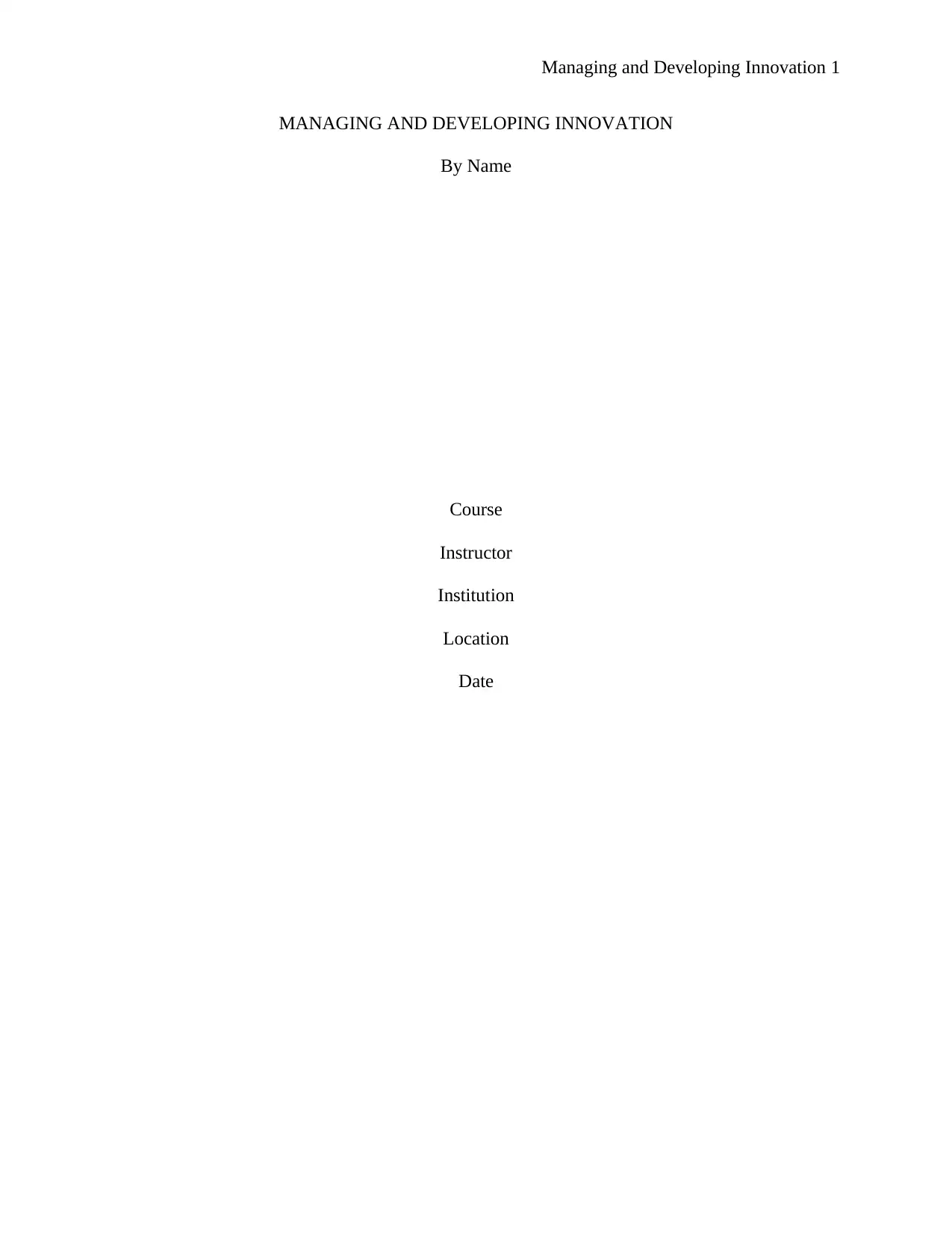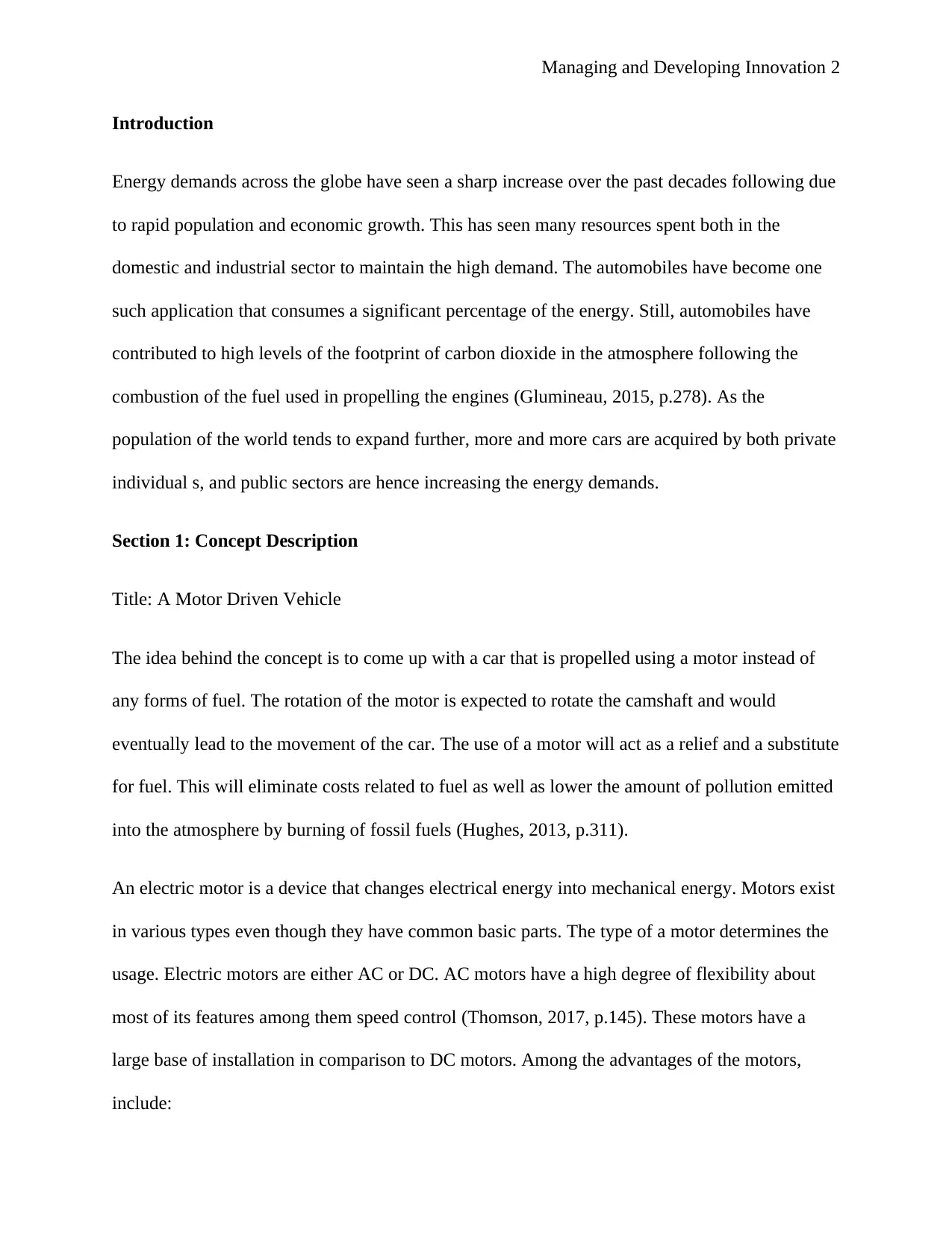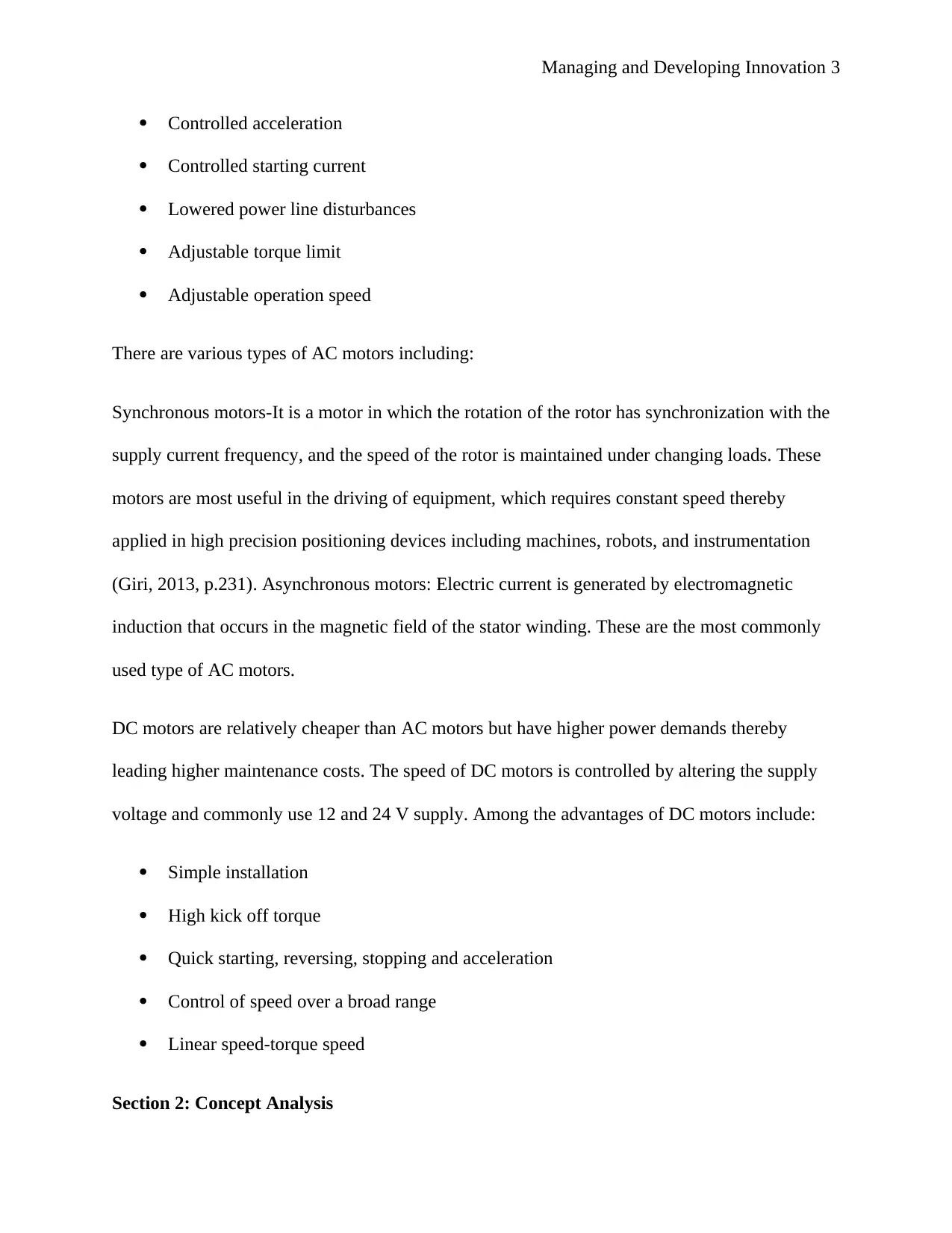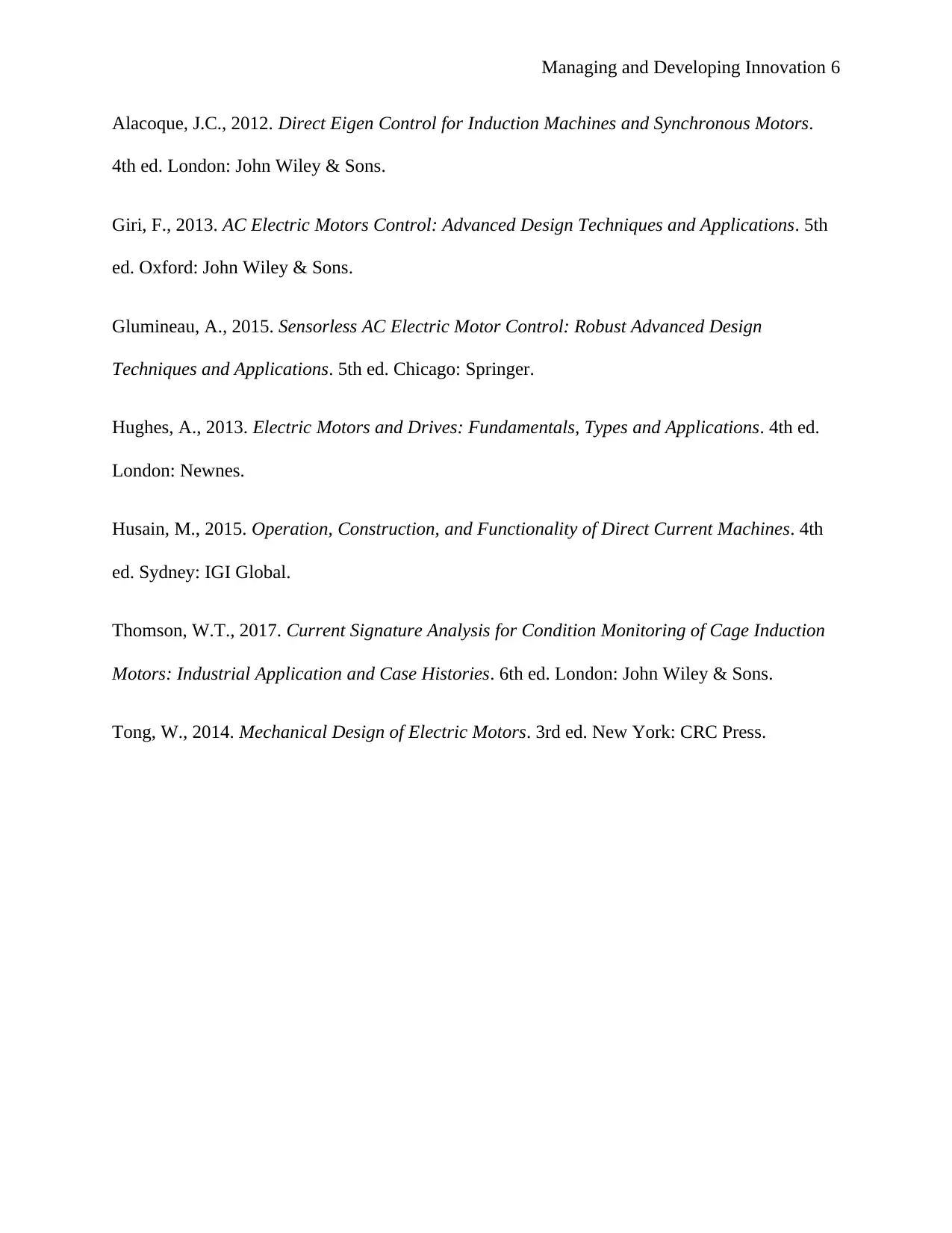University Innovation Report: Motor Driven Vehicle Concept Analysis
VerifiedAdded on 2021/04/24
|6
|1327
|36
Report
AI Summary
This report examines the concept of a motor-driven vehicle as a solution to global energy demands and environmental concerns, focusing on replacing traditional fuel-based engines with electric motors. The report begins with an introduction highlighting the increasing energy consumption and the environmental impact of automobiles. Section 1 describes the core concept of a motor-driven vehicle, detailing the use of AC and DC electric motors, and their advantages, such as controlled acceleration and adjustable speed. Section 2 analyzes the competitive advantages of the motor-driven vehicle, including cost reduction and environmental benefits, while also acknowledging the weakness of energy conversion efficiency. Section 3 outlines the skills and team required for the innovation, emphasizing the importance of knowledge in motor technology and the need for a team of automotive engineering professionals. The report concludes by summarizing the potential of the motor-driven vehicle to contribute to energy conservation, reduce maintenance costs, and attract investments in the automobile industry. The report also references several sources to support the claims.

Managing and Developing Innovation 1
MANAGING AND DEVELOPING INNOVATION
By Name
Course
Instructor
Institution
Location
Date
MANAGING AND DEVELOPING INNOVATION
By Name
Course
Instructor
Institution
Location
Date
Paraphrase This Document
Need a fresh take? Get an instant paraphrase of this document with our AI Paraphraser

Managing and Developing Innovation 2
Introduction
Energy demands across the globe have seen a sharp increase over the past decades following due
to rapid population and economic growth. This has seen many resources spent both in the
domestic and industrial sector to maintain the high demand. The automobiles have become one
such application that consumes a significant percentage of the energy. Still, automobiles have
contributed to high levels of the footprint of carbon dioxide in the atmosphere following the
combustion of the fuel used in propelling the engines (Glumineau, 2015, p.278). As the
population of the world tends to expand further, more and more cars are acquired by both private
individual s, and public sectors are hence increasing the energy demands.
Section 1: Concept Description
Title: A Motor Driven Vehicle
The idea behind the concept is to come up with a car that is propelled using a motor instead of
any forms of fuel. The rotation of the motor is expected to rotate the camshaft and would
eventually lead to the movement of the car. The use of a motor will act as a relief and a substitute
for fuel. This will eliminate costs related to fuel as well as lower the amount of pollution emitted
into the atmosphere by burning of fossil fuels (Hughes, 2013, p.311).
An electric motor is a device that changes electrical energy into mechanical energy. Motors exist
in various types even though they have common basic parts. The type of a motor determines the
usage. Electric motors are either AC or DC. AC motors have a high degree of flexibility about
most of its features among them speed control (Thomson, 2017, p.145). These motors have a
large base of installation in comparison to DC motors. Among the advantages of the motors,
include:
Introduction
Energy demands across the globe have seen a sharp increase over the past decades following due
to rapid population and economic growth. This has seen many resources spent both in the
domestic and industrial sector to maintain the high demand. The automobiles have become one
such application that consumes a significant percentage of the energy. Still, automobiles have
contributed to high levels of the footprint of carbon dioxide in the atmosphere following the
combustion of the fuel used in propelling the engines (Glumineau, 2015, p.278). As the
population of the world tends to expand further, more and more cars are acquired by both private
individual s, and public sectors are hence increasing the energy demands.
Section 1: Concept Description
Title: A Motor Driven Vehicle
The idea behind the concept is to come up with a car that is propelled using a motor instead of
any forms of fuel. The rotation of the motor is expected to rotate the camshaft and would
eventually lead to the movement of the car. The use of a motor will act as a relief and a substitute
for fuel. This will eliminate costs related to fuel as well as lower the amount of pollution emitted
into the atmosphere by burning of fossil fuels (Hughes, 2013, p.311).
An electric motor is a device that changes electrical energy into mechanical energy. Motors exist
in various types even though they have common basic parts. The type of a motor determines the
usage. Electric motors are either AC or DC. AC motors have a high degree of flexibility about
most of its features among them speed control (Thomson, 2017, p.145). These motors have a
large base of installation in comparison to DC motors. Among the advantages of the motors,
include:

Managing and Developing Innovation 3
Controlled acceleration
Controlled starting current
Lowered power line disturbances
Adjustable torque limit
Adjustable operation speed
There are various types of AC motors including:
Synchronous motors-It is a motor in which the rotation of the rotor has synchronization with the
supply current frequency, and the speed of the rotor is maintained under changing loads. These
motors are most useful in the driving of equipment, which requires constant speed thereby
applied in high precision positioning devices including machines, robots, and instrumentation
(Giri, 2013, p.231). Asynchronous motors: Electric current is generated by electromagnetic
induction that occurs in the magnetic field of the stator winding. These are the most commonly
used type of AC motors.
DC motors are relatively cheaper than AC motors but have higher power demands thereby
leading higher maintenance costs. The speed of DC motors is controlled by altering the supply
voltage and commonly use 12 and 24 V supply. Among the advantages of DC motors include:
Simple installation
High kick off torque
Quick starting, reversing, stopping and acceleration
Control of speed over a broad range
Linear speed-torque speed
Section 2: Concept Analysis
Controlled acceleration
Controlled starting current
Lowered power line disturbances
Adjustable torque limit
Adjustable operation speed
There are various types of AC motors including:
Synchronous motors-It is a motor in which the rotation of the rotor has synchronization with the
supply current frequency, and the speed of the rotor is maintained under changing loads. These
motors are most useful in the driving of equipment, which requires constant speed thereby
applied in high precision positioning devices including machines, robots, and instrumentation
(Giri, 2013, p.231). Asynchronous motors: Electric current is generated by electromagnetic
induction that occurs in the magnetic field of the stator winding. These are the most commonly
used type of AC motors.
DC motors are relatively cheaper than AC motors but have higher power demands thereby
leading higher maintenance costs. The speed of DC motors is controlled by altering the supply
voltage and commonly use 12 and 24 V supply. Among the advantages of DC motors include:
Simple installation
High kick off torque
Quick starting, reversing, stopping and acceleration
Control of speed over a broad range
Linear speed-torque speed
Section 2: Concept Analysis
⊘ This is a preview!⊘
Do you want full access?
Subscribe today to unlock all pages.

Trusted by 1+ million students worldwide

Managing and Developing Innovation 4
Being propelled using the motors rather than fuel or electricity, motor driven cars will not require
any forms of fuel hence will be less costly to the consumers (Husain, 2015, p.258). This will
reduce expenses related to maintaining the automobiles and hence the competitive advantage.
Still, another competitive advantage of the car will be environmental conservation in which
while the cars are propelled on fossil fuels emit smoke and various other forms of pollution,
motor driven cars are environmentally friendly and do not increase the amount of carbon dioxide
into the atmosphere. In order to maintain this competitive advantage, advanced motors will be
adopted. These motors will be advanced in the aspect of the rate and amount of electrical energy
converted to mechanical energy (Tong, 2014, p.179). The higher the amount of electrical energy
converted to mechanical energy the greater the efficiency of the automobile and hence better
performance. This will form the basis of maintaining the competitive advantage of the car.
In this project, it will be assumed that the motors will propel the cam shaft, which will, in turn,
bring about the movement of the car. The main weakness of the project will be the amount of
mechanical energy generated from conversion of electrical energy (Alacoque, 2012, p.293). The
mechanical energy may be too low to move the car a longer distance. Use of modified and
advanced motors will help in addressing the concern. Such advanced and modified motors will
be able to increase the production of mechanical energy.
Section 3: Skills & Team Required
Knowledge and understanding of motors, the various types and how they operate will be an
integral aspect of this innovation. Using the knowledge in motors, it will be possible to choose
the most suitable motor for the motor driven car (Alacoque, 2012, p.211). The knowledge will
also be fundamental in the identification of the modifications that will need to be done on the
Being propelled using the motors rather than fuel or electricity, motor driven cars will not require
any forms of fuel hence will be less costly to the consumers (Husain, 2015, p.258). This will
reduce expenses related to maintaining the automobiles and hence the competitive advantage.
Still, another competitive advantage of the car will be environmental conservation in which
while the cars are propelled on fossil fuels emit smoke and various other forms of pollution,
motor driven cars are environmentally friendly and do not increase the amount of carbon dioxide
into the atmosphere. In order to maintain this competitive advantage, advanced motors will be
adopted. These motors will be advanced in the aspect of the rate and amount of electrical energy
converted to mechanical energy (Tong, 2014, p.179). The higher the amount of electrical energy
converted to mechanical energy the greater the efficiency of the automobile and hence better
performance. This will form the basis of maintaining the competitive advantage of the car.
In this project, it will be assumed that the motors will propel the cam shaft, which will, in turn,
bring about the movement of the car. The main weakness of the project will be the amount of
mechanical energy generated from conversion of electrical energy (Alacoque, 2012, p.293). The
mechanical energy may be too low to move the car a longer distance. Use of modified and
advanced motors will help in addressing the concern. Such advanced and modified motors will
be able to increase the production of mechanical energy.
Section 3: Skills & Team Required
Knowledge and understanding of motors, the various types and how they operate will be an
integral aspect of this innovation. Using the knowledge in motors, it will be possible to choose
the most suitable motor for the motor driven car (Alacoque, 2012, p.211). The knowledge will
also be fundamental in the identification of the modifications that will need to be done on the
Paraphrase This Document
Need a fresh take? Get an instant paraphrase of this document with our AI Paraphraser

Managing and Developing Innovation 5
motors in order to improve the efficiency of the car. Such modifications will be among them the
speed of rotation of the motor that would be important in increasing the amount of electrical
energy converted to mechanical energy (Husain, 2015, p.188). A team of professionals with
expertise in automotive engineering and vehicle assemblage and parts will be one of such teams
that will be most needed to help in providing insights into how to link the innovation with the
contemporary knowledge. Since the idea will mean a complete overhaul of the propulsion system
of a car, the team will help in guiding throughout the innovation process on how to ensure the
linkage works.
Conclusion
A motor-driven vehicle car is a significant aspect of solving the energy problems experienced
around the globe. Through this technology, energy consumption by cars is eliminated and instead
a motor is used in place of fossil fuels. Environmental sustainability is yet another advantage
associated with this technology, which will only need a powerful motor to get the automobile
moving. When refined and fully developed, the innovation will form a great contributor to
energy conservation and efficiency as well as reduce to significant levels the cost of maintaining
cars. This will attract more investments in the automobile industry thereby affecting positively
on the economic development of regions and countries.
References
motors in order to improve the efficiency of the car. Such modifications will be among them the
speed of rotation of the motor that would be important in increasing the amount of electrical
energy converted to mechanical energy (Husain, 2015, p.188). A team of professionals with
expertise in automotive engineering and vehicle assemblage and parts will be one of such teams
that will be most needed to help in providing insights into how to link the innovation with the
contemporary knowledge. Since the idea will mean a complete overhaul of the propulsion system
of a car, the team will help in guiding throughout the innovation process on how to ensure the
linkage works.
Conclusion
A motor-driven vehicle car is a significant aspect of solving the energy problems experienced
around the globe. Through this technology, energy consumption by cars is eliminated and instead
a motor is used in place of fossil fuels. Environmental sustainability is yet another advantage
associated with this technology, which will only need a powerful motor to get the automobile
moving. When refined and fully developed, the innovation will form a great contributor to
energy conservation and efficiency as well as reduce to significant levels the cost of maintaining
cars. This will attract more investments in the automobile industry thereby affecting positively
on the economic development of regions and countries.
References

Managing and Developing Innovation 6
Alacoque, J.C., 2012. Direct Eigen Control for Induction Machines and Synchronous Motors.
4th ed. London: John Wiley & Sons.
Giri, F., 2013. AC Electric Motors Control: Advanced Design Techniques and Applications. 5th
ed. Oxford: John Wiley & Sons.
Glumineau, A., 2015. Sensorless AC Electric Motor Control: Robust Advanced Design
Techniques and Applications. 5th ed. Chicago: Springer.
Hughes, A., 2013. Electric Motors and Drives: Fundamentals, Types and Applications. 4th ed.
London: Newnes.
Husain, M., 2015. Operation, Construction, and Functionality of Direct Current Machines. 4th
ed. Sydney: IGI Global.
Thomson, W.T., 2017. Current Signature Analysis for Condition Monitoring of Cage Induction
Motors: Industrial Application and Case Histories. 6th ed. London: John Wiley & Sons.
Tong, W., 2014. Mechanical Design of Electric Motors. 3rd ed. New York: CRC Press.
Alacoque, J.C., 2012. Direct Eigen Control for Induction Machines and Synchronous Motors.
4th ed. London: John Wiley & Sons.
Giri, F., 2013. AC Electric Motors Control: Advanced Design Techniques and Applications. 5th
ed. Oxford: John Wiley & Sons.
Glumineau, A., 2015. Sensorless AC Electric Motor Control: Robust Advanced Design
Techniques and Applications. 5th ed. Chicago: Springer.
Hughes, A., 2013. Electric Motors and Drives: Fundamentals, Types and Applications. 4th ed.
London: Newnes.
Husain, M., 2015. Operation, Construction, and Functionality of Direct Current Machines. 4th
ed. Sydney: IGI Global.
Thomson, W.T., 2017. Current Signature Analysis for Condition Monitoring of Cage Induction
Motors: Industrial Application and Case Histories. 6th ed. London: John Wiley & Sons.
Tong, W., 2014. Mechanical Design of Electric Motors. 3rd ed. New York: CRC Press.
⊘ This is a preview!⊘
Do you want full access?
Subscribe today to unlock all pages.

Trusted by 1+ million students worldwide
1 out of 6
Related Documents
Your All-in-One AI-Powered Toolkit for Academic Success.
+13062052269
info@desklib.com
Available 24*7 on WhatsApp / Email
![[object Object]](/_next/static/media/star-bottom.7253800d.svg)
Unlock your academic potential
Copyright © 2020–2025 A2Z Services. All Rights Reserved. Developed and managed by ZUCOL.





